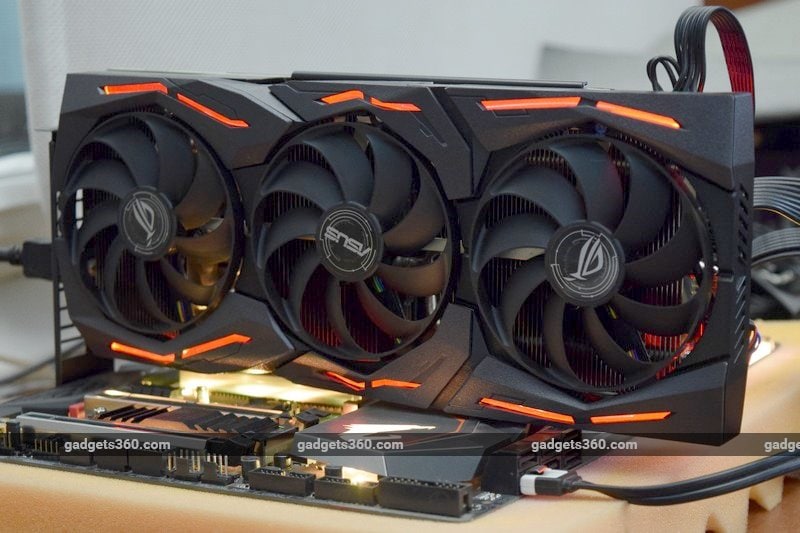Sometimes, when companies think it’s time for the world to move on to a new standard or format, they ruthlessly kill off older products or services and force people to change. The most famous example of this is of course Apple, with its relentless deprecation of floppy and optical drives, all ports other than USB Type-C, and most frustratingly, the 3.5mm headphones socket. On the other hand we have examples of about-face reversals, such as Microsoft’s universally hated “Modern” Windows 8 interface, its abysmal adoption rate as people refused to leave Windows 7, and the company’s resulting campaign of apologies and free Windows 10 upgrades.
Nvidia seems to have found itself in the latter camp. The company proudly unveiled its GeForce RTX series late last year, hoping that the allure of ray tracing would create a rush of demand for new, expensive graphics cards. That hasn’t been the case. The GeForce RTX 2080 Ti, 2080, and 2070 have been praised for their performance, but even now, barely any games support ray tracing and those that do have very limited implementations for specific effects such as shadows in Shadow of the Tomb Raider and reflections in Battlefield V.
DLSS (Deep Learning Super-Sampling), the second major feature of the GeForce RTX series, has also been received poorly. This feature uses a neural network to help intelligently upscale graphics rendered at low resolutions, but image quality suffers in real-world tests, and again, very few games actually support it.
Nvidia has found itself in a sort-of chicken-and-egg situation — more games should support these features in the future, but that isn’t going to motivate people to upgrade now, and the GeForce RTX series cards are much too expensive to be bought as impulsive upgrades. Now, production and distribution of the GeForce GTX 10-series is reportedly winding down, leaving a gap in the market.
Enter the brand new GeForce GTX 1660 Ti, presumably the first of several models in a new series. This oddly-named specimen uses the same Turing architecture as the GeForce RTX 20-series, minus the ray tracing capabilities. This GPU can be considered a cut-down version of the recently launched GeForce RTX 2060 and is aimed at the mid-range market, typically gamers with a GeForce GTX 970 or GeForce GTX 960 graphics card who are ready to upgrade.
The high prices of GeForce RTX series cards has left them without a viable option — till now, that is. We have an Asus ROG Strix GeForce GTX 1660 Ti, and if you’ve been waiting to upgrade or build a new gaming PC, we’ll tell you if this is the answer to all your problems.
![]()
Nvidia GeForce GTX 1660 Ti specifications and features
First of all, let’s talk about this name — the GeForce GTX 1660 Ti has no precedent. As the GeForce GTX 10-series was due for a refresh, it was heavily rumoured that the next generation would be called the 11-series. Now that we have a 20-series instead, Nvidia has decided that its cut-down models will jump to 16xx.
Gadgets 360 asked an Nvidia representative about this in a pre-launch meeting, and we were told “16 is closer to 20 than 10”. That’s really all there is to it, and so much for continuity. At least that leaves room for a few more non-RTX generations. More interestingly, the use of the ‘Ti’ suffix predicates the eventual introduction of a hopefully even more affordable GeForce GTX 1660, which is already being rumoured.
The GeForce GTX 1660 Ti might also be the most heavily leaked PC component in recent history. We’ve seen everything about it from specifications to benchmark scores, renders, and even packaging from multiple partner brands. If you aren’t caught up, here’s what you need to know.
The GPU itself is codenamed TU116, and is not just an existing GeForce RTX GPU with sections disabled. It’s been fabricated from scratch without RT cores or Tensor cores. For an overview of the Turing architecture and what these components do, check out our complete overview of the architecture.
This makes sense for the price segment that Nvidia has targeted — even the high-end GeForce RTX models reportedly struggle when ray tracing is enabled, which means that a low-end GPU would not be able to handle that load anyway.
The TU116 GPU has 1,536 compute units called CUDA cores, arranged into 24 clusters called Streaming Multiprocessors. It has a base clock speed of 1500MHz and a maximum boost speed of 1770MHz, but board partners are free to tweak these values. You get 6GB of GDDR6 RAM running at 12Gbps on a 192-bit bus for up to 288GBps of peak memory bandwidth. The total TDP is a very manageable 120W.
![]() Nvidia GeForce GTX 1660 Ti (TU116) architecture block diagram
Nvidia GeForce GTX 1660 Ti (TU116) architecture block diagram
Most cards will have a single 8-pin PCIe power connector. For video outputs, Nvidia supports HDMI, DisplayPort, and even the older DVI standard in a clear nod to upgraders. Unlike the top-end GeForce RTX models, a VirtualLink USB Type-C port for single-cable connection to VR headsets, is not mandatory. Nvidia has said that its partners are free to choose their own port selection and implement VirtualLink, but it’s unlikely that they will given the target audience here.
That brings us to an interesting point — Nvidia is for some reason not releasing a Founders Edition graphics card featuring the GeForce GTX 1660 Ti GPU, breaking with its established pattern for mid-range to high-end models over the past few years. Board partners including Asus, Gigabyte, Zotac, MSI, EVGA, Palit, Galax, Inno3D and others released their own models with custom coolers, and in some cases factory overclocking, in markets around the world on launch day.
Compared to the GeForce GTX 1060 which this GPU replaces, Nvidia promises roughly a 1.5x performance boost. That’s down to architectural improvements such as the ability to run floating point and integer operations simultaneously, larger and better tuned caches, improved performance per clock cycle, and better power efficiency. Processing bandwidth is up from 4.4 TFLOPS to 11 TFLOPS. The Turing architecture also lets games selectively reduce the quality of shading in parts of scenes that are in the distance or in motion, but this needs to be supported by game developers.
Nvidia says that two-thirds of its user base is currently made up of GeForce GTX 960 users or lower. If you’re upgrading from that GPU, you stand to gain up to 3X the performance in some game titles. You’ll be able to play today’s popular Battle Royale games including Fortnite, Apex Legends, PUBG, and COD: Black Ops 4 at 120fps using High quality settings at 1080p. More demanding titles should still be able to run at over 60fps with quality settings turned all the way up.
Much like its competitor AMD, Nvidia is starting to draw attention to its software features including the Ansel screenshot tool, the Freestyle filtering app that lets you get creative with game visuals, and the Highlights recording tool that helps you capture shareable moments as you play. The GeForce Experience software helps you customise game settings to suit your PC’s hardware and manage driver updates.
Gamers might be a little disappointed that Nvidia is not offering any free games to GeForce GTX 1660 Ti buyers. Considering that all GeForce RTX series graphics card give you either Battlefield V, Anthem, or both, and AMD is being quite generous with Resident Evil 2, Tom Clancy’s The Division 2, and/or Devil May Cry 5 with its mid-range GPUs.
![]()
Asus ROG Strix GeForce GTX 1660 Ti OC 6GB
Asus is one of the world’s biggest PC hardware brands and it’s no surprise that the company has shot out of the gate with multiple GeForce GTX 1660 Ti models. The one we have with us is gigantic by the standards of mid-range cards, with three fans. We’ve seen this exact cooler before on high-end Strix models, and it feels like overkill for a 120W GPU. The cooler extends way beyond the length of the card’s circuit board, and it’s taller than usual too. It’s listed as a two-slot card, but will block a third one.
The ROG Strix GeForce GTX 1660 Ti has slightly raised base and boost clocks of 1530MHz and up to 1890MHz respectively. Asus also boasts that its cooler’s contact surface has been optimised for heat transfer, and says it has used high-quality capacitors and chokes for power regulation. There’s a switch on the rear to let you select ‘Performance’ or ‘Quiet’ modes.
The fans are unusual in that the ends of the blades all meet a ring that spins around. Asus says this “barrier ring” increases air pressure. Of course you get RGB LED lighting, in aggressive-looking slashes placed in a deliberately random sort of fashion above and below the fans. The Republic of Gamers logo on the top is also lighted.
If you’re not a fan of this, a very handy surface-mount button on the rear of the card lets you instantly disable all lighting effects. You can use Asus’ Aura Sync software to synchronise lighting effects with other compatible hardware you might have. There’s even an Aura RGB header on the back so you can control and sync other RGB LED hardware or light strips to jazz up your PC.
You get two HDMI 2.0b ports and two DisplayPort 1.4 ports. The rear end of the card has a nice black anodised finish, and there’s even a backplate for rigidity. On the inside, there are two fan headers so you can have some or all case fans spin up when the GPU is stressed rather than taking their cues from the CPU and motherboard. As a last little bonus, you get a Velcro cable tie in the box with this card.
The Asus ROG Strix GeForce GTX 1660 Ti is certainly an impressive-looking card. If you’re looking for more practical options, Asus and most other brands offer single- and dual-fan GeForce GTX 1660 Ti cards with this GPU.
![]()
Asus ROG Strix GeForce GTX 1660 Ti OC 6GB performance
Our test bench is built using an AMD Ryzen 7 2700X CPU, Gigabyte Aorus X470 Gaming 7 Wifi motherboard, 2x8GB of G.skill DDR4 RAM, a 1TB Samsung SSD 860 Evo boot drive, and Corsair RM650 power supply. We used Windows 10 (version 1803 with all current patches) and a pre-release graphics driver supplied by Nvidia, version number 418.91. Our trusty Asus PB287Q 4K monitor served for all game and benchmark tests. We’ll be comparing scores to the older GeForce GTX 1060 and AMD’s closest priced competition, the Radeon RX 590. We haven’t yet reviewed the GeForce RTX 2060 fully, but we do have test results from an Asus ROG Strix GeForce RTX 2060 OC 6GB for reference.
Our Asus Strix GeForce GTX 1660 Ti was set to Performance mode for all our tests. Beginning of course with synthetic tests, we saw the GeForce GTX 1660 Ti GPU score 6,641 in the 3DMark Time Spy DX12 test, compared to the 4,273 that our fastest tested GeForce GTX 1060 managed. In contrast, the GeForce RTX 2060 managed 7,953 and the Radeon RX 590 scored 5,182. The pattern was similar for the less intensive 3DMark Fire Strike tests. You can see all the scores in the table below.
We ran the Unigine Valley benchmark using the Ultra preset at 1920×1080 and got an average of 78.6fps. The Star Swarm stress test ran smoothly with an average of 77.89fps. The GeForce GTX 1660 Ti beats its competition from AMD, but surprisingly trades blows with the GeForce GTX 1060 in some situations when it should have been on par with the GeForce GTX 1070.
| Asus ROG Strix GeForce GTX 1660 Ti OC 6GB | Asus ROG Strix GeForce RTX 2060 OC 6GB | MSI GeForce GTX 1060 Gaming X | MSI GeForce GTX 1070 Gaming X | Sapphire Nitro+ Radeon RX590 | |
|---|---|---|---|---|---|
| 3DMark Time Spy | 6,641 | 7,953 | 4,273 | NA | 5,182 |
| 3DMark Time Spy Extreme | 2,980 | 3,616 | NA | NA | NA |
| 3DMark Fire Strike | 14,324 | 16,578 | 11,421 | 15,559 | 13,969 |
| 3DMark Fire Strike Extreme | 7,267 | 9,005 | 6,017 | 8,305 | 6,999 |
| 3DMark Fire Strike Ultra | 3,463 | 4,552 | 3,168 | 4,523 | 3,743 |
| Unigine Valley (1920×1080, Ultra, 8xAA) | 78.6fps | 92.3fps | 68.9fps | 95.3fps | 60fps |
Next, we ran through some of the built-in benchmarks that games offer. These are standardised runs that allow us to evaluate the differences between GPUs as they handle identical test conditions. We ran through Far Cry 5’s benchmark first at 1920×1080 using the Ultra preset and got a very pleasant 87fps with almost no visible stuttering on screen. Out of curiosity, we bumped up the resolution to 2560×1440 and got 67fps, and then to 4K and got 35fps which was rather choppy. You’ll have to trade off on quality if you want high resolutions, but that’s not this GPU’s target market.
We then turned to Metro: Last Light Redux. At 1920×1080, using the Very High preset and 4xAF, our average score was a very impressive 116.74fps. We were able to turn SSAA on to improve visual quality, and that sent the frame rate down to 66.6fps which is still not bad. Without SSAA, we got 73.91fps at 2560×1440 and 34.85fps at 4K.
Shadow of the Tomb Raider’s internal benchmark managed 82fps, 54fps and 27fps at the three resolutions respectively, using the Highest quality preset with TAA enabled. Deus Ex: Mankind Divided gave us 61fps at 1920×1080 using its Ultra preset with MSAA turned off, and raising the resolution made the game too choppy for our liking.
We then spent some time playing through games manually. Starting with the graphics-intensive Witcher 3: Wild Hunt, we used the Ultra preset with the resolution set to 1920×1080, and post-processing set to High. Using the FRAPS frame-time measurement tool, we saw an average of 65fps with barely noticeable intermittent hiccups. Doom (2016) actually stayed consistently above 60fps even when played at 4K using the Ultra preset. This game is known to scale well to weaker hardware, so it shows how well older and less demanding games will run.
We were happy to see that one of the benefits of Asus’ oversized cooler is that in Quiet mode, the fans can spin down completely when the card is not being stressed. While playing games, we saw the fans spin up but could barely hear them even in a very quiet room. This is something you might want to consider if you don’t like being distracted by loud fans.
![]()
Verdict
We’re finally at the end of the cryptocurrency boom, which marked a torturous period when graphics cards were overpriced and unavailable. Unfortunately, cards still remain overpriced in India thanks to weak currency exchange rates and Indian import taxes. The GeForce GTX 1660 Ti comes as some relief, delivering performance that’s usually at par with the GeForce GTX 1070 for the price of the GeForce GTX 1060. If you’ve been itching to upgrade, this is the most tempting option we’ve seen in a long time.
We don’t mind the loss of RTX ray tracing and DLSS functionality at all, and we’re sure most gamers won’t either. If you’re gaming at 1920×1080, you’ll have no problems whatsoever, and there’s even scope for some games to go up to higher resolutions. Sure, the recently released Metro: Exodus seems to make good use of ray tracing for lighting effects, but that’s just one drop in a very large bucket. On the other hand, if you think that you’ll use your graphics card for several years and don’t want to feel like you’re missing out, you could pay relatively little more for the GeForce RTX 2060 and enjoy slightly better performance too.
Unfortunately Nvidia isn’t selling a Founders Edition graphics card of its own, because they tend to cost less than even the most basic partner cards. In fact, you could pick up a GeForce RTX 2060 Founders’ Edition for much less than what the Asus ROG Strix GeForce GTX 1660 Ti OC 6GB costs, and a GeForce GTX 1070 Founders’ Edition for around the same amount. Asus’ pricing just doesn’t make a lot of sense considering that this GPU was intended to target value-conscious buyers.
Ultimately, that’s the only problem we have with the Asus ROG Strix GeForce GTX 1660 Ti OC 6GB, but it’s an insurmountable one. This card performs very well, but then no other graphics card with the same GPU will be far behind. Its MRP of Rs. 40,500 in India is simply far too high for the category of GPU that the GTX 1660 Ti should be in.
Asus’s own Phoenix GeForce GTX 1660 Ti, which has a single fan, is listed for Rs. 27,200 and other brands go as low as Rs. 25,500 (which is exactly in line with Nvidia’s $279 recommended price plus 28 percent for taxes in India). Sure, the Strix card looks impressive and has an excellent cooler. You could choose this card if you really want to try GPU overclocking, but for most people, a simpler variant will be the way to go.
Finally, we’ve seen that AMD’s Radeon RX 590 is not very competitive with the GeForce GTX 1660 Ti at 1920×1080, but watch out for deals on the Radeon Vega 56 – it might not be able to match Nvidia’s base price, but it can certainly be considered an alternative if you’re looking at premium-priced variants.
Asus ROG Strix GeForce GTX 1660 Ti OC 6GB
Price: MRP: Rs. 40,500
Pros:
- Excellent performance at 1920×1080
- High-end cooler with RGB LED effects
- Very quiet even under load
Cons:
Ratings (out of 5)
Performance: 4.5
Value for Money: 2.5
Overall: 3.5



